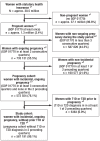The Prevalence of Gestational Diabetes
- PMID: 28669379
- PMCID: PMC5499505
- DOI: 10.3238/arztebl.2017.0412
The Prevalence of Gestational Diabetes
Abstract
Background: Gestational diabetes mellitus (GDM) is defined as a glucose tolerance disorder that arises during pregnancy. Estimates of its prevalence vary widely because of varying threshold values. Screening of all pregnant women with a two-step test has been available in Germany since 2012. This study is the first population-based, nationwide analysis of the screening coverage and the resulting one-year prevalence.
Methods: Billing data from the outpatient sector were analyzed for all persons covered by statutory health insurance in the two-year period 2014-2015. A cohort of pregnant women, constructed by using pregnancy care billing data, was studied with respect to the screening coverage. The prevalence of GDM was determined from the use of the corresponding ICD-10-GM codes.
Results: 80.8% of 567 191 pregnant women were screened for GDM. Most of them (63.3%) received only the pre-test, and 12.7% received both the pre-test and the diagnostic test. 4.8% received only the diagnostic test. The overall prevalence of GDM was 13.2%. The prevalence rose with age, from 8% to 26% in women aged 45 or older. Younger women more commonly received only the pre-test; the frequency of receiving both tests rose with age.
Conclusion: Screening for GDM is comprehensively implemented. The analysis of billing data reveals a relatively high prevalence that accords with estimates in other countries, implying that earlier prevalence figures for Germany were probably underestimates.
Figures




Comment in
-
Helpful or Harmful?Dtsch Arztebl Int. 2017 Oct 13;114(41):689. doi: 10.3238/arztebl.2017.0689a. Dtsch Arztebl Int. 2017. PMID: 29082859 Free PMC article. No abstract available.
-
Statistics Visualization not Very Successful.Dtsch Arztebl Int. 2017 Oct 13;114(41):689. doi: 10.3238/arztebl.2017.0689b. Dtsch Arztebl Int. 2017. PMID: 29082860 Free PMC article. No abstract available.
-
Deeper Analysis Desirable.Dtsch Arztebl Int. 2017 Oct 13;114(41):689-690. doi: 10.3238/arztebl.2017.0689c. Dtsch Arztebl Int. 2017. PMID: 29082861 Free PMC article. No abstract available.
-
Not a Population-Based Survey.Dtsch Arztebl Int. 2017 Oct 13;114(41):690. doi: 10.3238/arztebl.2017.0690a. Dtsch Arztebl Int. 2017. PMID: 29082862 Free PMC article. No abstract available.
References
-
- Kleinwechter H, Schäfer-Graf U, Buhrer C, et al. Gestational diabetes mellitus (GDM) diagnosis, therapy and follow-up care: practice guideline of the German Diabetes Association (DDG) and the German Association for Gynaecology and Obstetrics (DGGG) Exp Clin Endocrinol Diabetes. 2014;122:395–405. - PubMed
-
- American Diabetes Association. Classification and diagnosis of diabetes. Diabetes Care. 2016;39(1):S13–S22. - PubMed
-
- Crowther CA, Hiller JE, Moss JR, et al. Effect of treatment of gestational diabetes mellitus on pregnancy outcomes. N Engl J Med. 2005;352:2477–2486. - PubMed
-
- Metzger BE, Lowe LP, Dyer AR, et al. Hyperglycemia and adverse pregnancy outcomes. N Engl J Med. 2008;358:1991–2002. - PubMed
MeSH terms
LinkOut - more resources
Full Text Sources
Other Literature Sources
Medical

